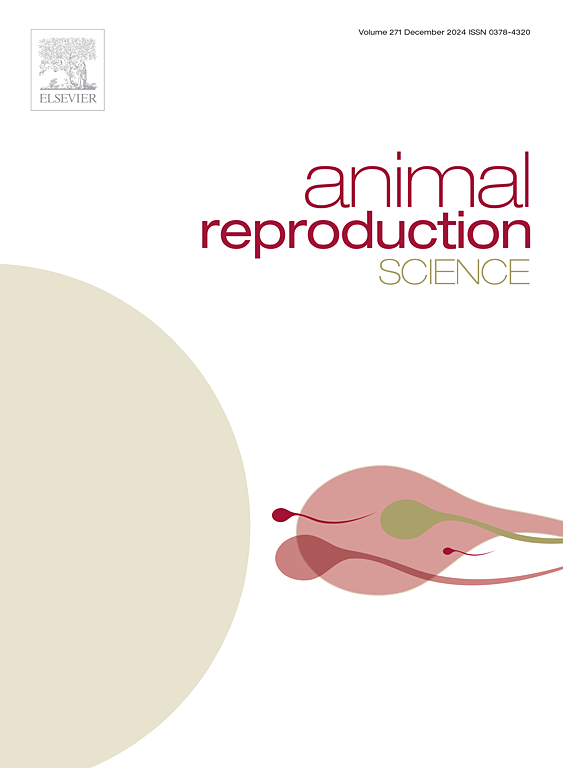Seminal extracellular vesicles influence porcine spermatozoa physiology by modulating key functional parameters
IF 3.3
2区 农林科学
Q1 AGRICULTURE, DAIRY & ANIMAL SCIENCE
引用次数: 0
Abstract
Seminal plasma (SP) contains a heterogeneous population of extracellular vesicles (EVs) recognized as key modulators of sperm function. However, the specific functional roles of each seminal EV (sEV) subset remain poorly understood. This study aimed to evaluate the interaction of two sized sEV subsets (small [S-sEVs] and large [L-sEVs]) with pig liquid-stored spermatozoa under different pH conditions and their effect on specific sperm functional parameters. Seminal EV subsets were isolated from SP samples using size exclusion chromatography and characterized following the MISEV2023 guidelines. Semen samples were incubated with each sEV subset or without sEVs (control) for 6 h at 37 ºC, 100 % humidity and 5 % CO₂ under different pH conditions (6.5, 7.0, or 7.5). Sperm functional parameters were assessed by flow cytometry (Cytoflex®S and LX, Beckman Coulter), under capacitating and non-capacitating conditions. Confocal microscopy revealed that both sEV subsets bound to and were internalized by spermatozoa as early as 30 min after incubation, regardless of pH. Flow cytometry revealed that both sEVs decreased reactive oxygen species production (P ≤ 0.0001), mitochondrial membrane potential (P ≤ 0.0001) and mitochondrial O₂•⁻ levels (P ≤ 0.01) and increased apoptosis (active caspase-3) in viable spermatozoa (P ≤ 0.0001). However, the influence of sEV on acrosome integrity in viable sperm was time- and condition-dependent (P ≤ 0.05). This study showed that both S- and L-sEVs interact with porcine spermatozoa across a range of physiological pH conditions. This interaction is reflected by decreased oxidative stress and mitochondrial activity, as well as increased apoptosis in spermatozoa.
精子细胞外囊泡通过调节关键功能参数影响猪精子生理。
精浆(SP)含有异质性的细胞外囊泡(ev),被认为是精子功能的关键调节剂。然而,每个种子EV (sEV)子集的具体功能角色仍然知之甚少。本研究旨在评估两种大小的sEV亚群(小[s -sEV]和大[l -sEV])在不同pH条件下与猪液体储存精子的相互作用及其对精子特定功能参数的影响。使用大小排除色谱法从SP样品中分离出种子EV亚群,并按照MISEV2023指南进行表征。精液样本在37ºC, 100 %湿度和5 % CO₂条件下(6.5,7.0或7.5)与每个sEV子集或不含sEV(对照)孵育6 h。通过流式细胞术(Cytoflex®S和LX, Beckman Coulter)评估精子在获能和非获能条件下的功能参数。共焦显微镜显示绑定到子集签订和内化的精子早在孵化后30 min,无论博士流式细胞术显示,股票减少活性氧生产(P ≤0.0001 ),线粒体膜电位(P ≤0.0001 )和线粒体O₂•⁻水平(P ≤0.01 )和增加细胞凋亡(活跃caspase-3)可行的精子(P ≤ 0.0001)。sEV对活精子顶体完整性的影响具有时间和条件依赖性(P ≤ 0.05)。这项研究表明,S- sev和l - sev在一系列生理pH条件下与猪精子相互作用。这种相互作用反映在氧化应激和线粒体活性降低,以及精子细胞凋亡增加。
本文章由计算机程序翻译,如有差异,请以英文原文为准。
求助全文
约1分钟内获得全文
求助全文
来源期刊

Animal Reproduction Science
农林科学-奶制品与动物科学
CiteScore
4.50
自引率
9.10%
发文量
136
审稿时长
54 days
期刊介绍:
Animal Reproduction Science publishes results from studies relating to reproduction and fertility in animals. This includes both fundamental research and applied studies, including management practices that increase our understanding of the biology and manipulation of reproduction. Manuscripts should go into depth in the mechanisms involved in the research reported, rather than a give a mere description of findings. The focus is on animals that are useful to humans including food- and fibre-producing; companion/recreational; captive; and endangered species including zoo animals, but excluding laboratory animals unless the results of the study provide new information that impacts the basic understanding of the biology or manipulation of reproduction.
The journal''s scope includes the study of reproductive physiology and endocrinology, reproductive cycles, natural and artificial control of reproduction, preservation and use of gametes and embryos, pregnancy and parturition, infertility and sterility, diagnostic and therapeutic techniques.
The Editorial Board of Animal Reproduction Science has decided not to publish papers in which there is an exclusive examination of the in vitro development of oocytes and embryos; however, there will be consideration of papers that include in vitro studies where the source of the oocytes and/or development of the embryos beyond the blastocyst stage is part of the experimental design.
 求助内容:
求助内容: 应助结果提醒方式:
应助结果提醒方式:


